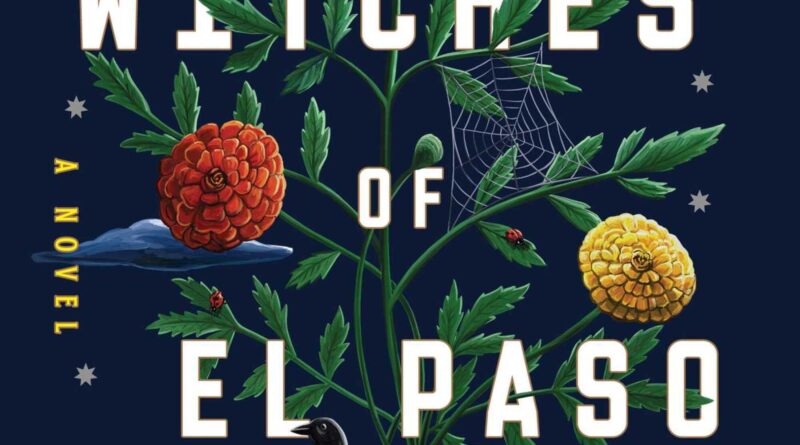De Los reads: Luis Jaramillo’s ‘The Witches of El Paso’ and other books by Latino authors we read in November
As the temperature begins to drop, we welcome the arrival of the good season – an exciting time to read in a captivating way. Whether you’re sitting on the couch or lying in bed, there’s something uniquely comforting about reading a good book or a great story while enjoying your favorite beverage.
Embracing an inviting spirit this month, a writer and professor of creative writing Luis Jaramillo shared with De Los his new book, “The Witches of El Paso,” a fascinating coming-of-age novel that takes readers on a journey back through time and generations. It follows the story of two women, Nena and Marta, who are determined to escape their challenging realities in different life situations, from 1940 to the present, by using their abilities to collaborate with “La Vista,” the source he is a powerful magician. in an aquelarre (coven) of monks from the secret place of the monks.
Jaramillo has lived in New York City for the past 25 years, but his roots go back to Salinas, Calif. – an agricultural community known for its strawberry and grape production. Growing up, his father worked as a farm labor lawyer while his mother taught their children English as a second language. During his childhood, Jaramillo lived for a while in El Paso, a place that left a lasting impression.

When he visited El Paso, it felt like a place of deep relationships – as if everyone is a cousin, familiar faces everywhere. This sense of intimacy made for a uniquely rich experience, one he had never experienced anywhere else.
“Sometimes we would go on Christmas, and it would be bright, the air was cold, and we would get hot chocolate,” Jaramillo said, adding that those trips were based on family tradition. In some ways, El Paso feels like my spiritual home.”
His inspiration for this book began with the stories of his family, particularly his grandmother and sisters, who grew up in El Paso in the late 1930s and came of age during World War II. The world. These women were strong and intelligent – her grandmother even received a Fulbright scholarship to Southern Methodist University, although she was unable to attend due to family financial constraints.
Jaramillo was interested in exploring these obstacles for women, especially those related to racism, poverty and gender. He wanted to capture the challenges they endured but also the opportunities they envisioned to overcome those limitations. To bring these ideas to life, he has incorporated elements of magic into his writing by introducing some real facts for the main characters.
Marta, one of the main characters in the book, who later met the power of “La Vista” says: “Magic is a way for people who don’t have the power to think that they can be powerful.
The analysis of the book of miracles has a lot to do with the cultural history of the areas of El Paso and New Mexico. These places have long been steeped in the stories of La Llorona, legends of witches and a unique blend of Catholicism and indigenous spiritual practices,” Jaramillo explains. Known today as the Land of the Enchanted, New Mexico’s identity is show an interest in landscapes and other ways of understanding the world.
While doing research for this book, he visited the Mercado Cuauhtémoc Mexican market in Juarez, Mexico, known for its focus on traditional healing methods such as. curanderismo and shamanism. There, he saw piles of fresh herbs, marigolds and other items used in rituals and cosmetics – including peyote root and real animal bones with their tails still attached – show how these amazing traditions are still alive. This rich mix is essential to frontier life, where many forms of knowledge and belief coexist in strong and enduring ways.
Magic is often portrayed as a force that can make things better, but in the case of “The Witches of El Paso,” it’s a force that brings more harm than good.
“I like the interpretation of the coming-of-age story as a story where someone has to sacrifice something or pay something to gain wisdom,” Jaramillo said. “I think the same thing is true with magic. Something has to be sacrificed or paid for that magic to appear in the world.”
This idea is embedded in the journeys of the characters, each of whom goes through a certain way – in time, going back and forth or from one stage of life to another, from youth to in old age. The author sees these passages as changes that naturally require sacrifice. For his personality, magic acts as a tool and an experiment, which offers potential benefits, but requires something more. Through this lens, he explores the balance of gain and loss that accompanies the use of magic, enhancing the narrative’s critical analysis of consequences and personal change.
This idea of crossing back and forth and the effects it produces on his people have similarities with life in El Paso, where people not only live in both, but also both. For many, crossing the border is a normal part of everyday life, be it at school, work or just for food.
“We all have a lot of creativity, and there’s a lot of energy [in] that creativity,” Jaramillo said. “Sometimes it feels like we don’t have a chance to find it but we do, and at key moments in our lives we realize what that creative power is.”
Jaramillo is scheduled to speak at Texas Book Festival Austin on Nov. 16 and 17.

De Los reads the November polls:
“The Days of Chavez Ravine” by Erik Sherman (University of Nebraska Press, May 2023)
Honoring the life of Fernando Valenzuela, this gripping book describes how the young Dodgers bridged cultural divides and healed old wounds in Los Angeles. The 21-year-old’s historic debut in 1981 sparked “Fernandomania”. His success on the field and in the community helped change the legacy of the Dodgers and turned him into a hero whose impact is connected to baseball and beyond. This book reveals the incredible influence of a figure that forever changed the American landscape of sports and culture.
“Clean up” by Alia Trabucco Zerán (Riverhead Books, October)
The story tells the story of Estela, a young woman from the countryside who discovers hidden secrets within the family she has served faithfully for seven years. As she cleans, cooks and raises the child of her employers, she sees the tension that continues in the family. Beneath her calm demeanor, Estela clung to their secrets, her sharp eyes capturing every unpleasant detail. After the tragic death of the couple’s daughter, she finally speaks out, revealing a harrowing tale of betrayal and the power of family.
“The Ofrenda we built” by Jolene Gutiérrez and Shaian Gutiérrez. Designed by Gabby Zapata. (Chronicles, August)
This delightful picture book brings Día de Muertos to life, celebrating the tradition of building an ofrenda as a family, layer by layer. Inspired by “The House That Jack Built,” it opens with a rhyming verse that invites readers of all ages to create a colorful altar with important symbols and memories. This book reminds readers that the spirit of this tradition lives on in love and unity, crossing generations and cultures alike.
#Los #reads #Luis #Jaramillos #Witches #Paso #books #Latino #authors #read #November
